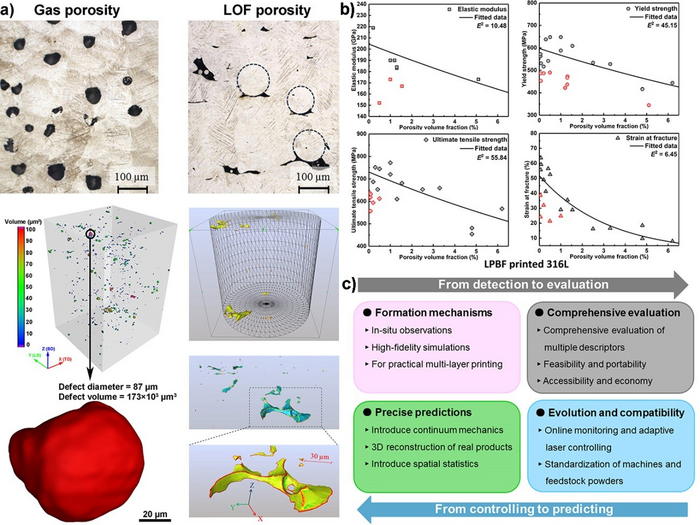The field of manufacturing technology is seeing rapid growth with the help of additive manufacturing (AM), sometimes referred to as 3D printing. With the use of AM technologies, things may now be manufactured directly from digital models, eliminating the geometric limitations of traditional design. When AM is processed, materials are “added” up, which sets it apart from typical subtractive and formative manufacturing.

Outline of the paper. (a) Two categories of the porosity in LPBF printed metals and their morphological characteristics; (b) relationship between tensile properties and porosity fractions of as-printed metals; and (c) the potential research opportunities. Image Credit: OEA
Additive manufacturing can produce a variety of materials, including metals, intermetallics, polymers, ceramics, and composites. A powder-bed-based AM technology and a unique area of laser engineering are called laser powder bed fusion (LPBF, also called selective laser melting). Numerous metallic materials can be accurately and superbly formed with LPBF, which has recently sparked great study interest.
Nevertheless, the flaws in LPBF printed metals have long caused concern. When printing varies from its ideal range, defects result. In LPBF printed metal products, typical flaws include fractures, voids, undesirable inclusion (such as unmelted particles), and lack of fusion (LOF).
For the qualification and use of LPBF printed metal goods, the study of the flaws and associated mechanical impacts is crucial. Porosity has a significant impact on the performance of goods printed by LPBF since it is a less harmful but more prevalent, difficult-to-eliminate defect.
How can porosity be efficiently suppressed and its genesis explained? How should the porosity be measured and assessed? What significant effects does porosity have on the mechanical properties of common structural metals? The purpose and focus of this study are to offer responses to these questions. The readers have been given a one-stop, comprehensive explanation of the porosity in LPBF printed metals, as well as in-depth numerical evaluations, based on both contemporary and classic literature.
The creation and assessment of porosity serve as the foundation of this essay. In the first section, two different types of porosity—gas porosity and LOF porosity—formation mechanisms are illustrated. To illustrate the formation process, recent research utilizing cutting-edge micro-CT and synchrotron X-ray imaging methods has been examined.
Four common measuring/evaluation methodologies and important porosity descriptors are also covered to compare their benefits, drawbacks, and application ranges.
In-depth research has also been done on the effects and key indicators of porosity under tensile and cyclic loading conditions.
To offer mechanical principles, numerical models, simulated results, and experimental data on the impact of porosity in LPBF printed metals, the paper has evaluated more than 200 research articles. Numerous Inconel 718 alloys, 316L steel, Ti-6Al-4V alloy, and AlSi10Mg alloy tensile characteristics have been collated.
The ductility of a certain metal changes along with the level of porosity that is acceptable. To establish the association between porosity percentage and tensile properties of four sample metals, innovative statistical models have been suggested based on the data gathered.
Based solely on the porosity fraction estimates, the fitted equations for elastic modulus, yield strength, ultimate tensile strength, and strain at fracture can offer a rapid estimation of the important mechanical parameters.
To provide additional support for engineering applications, the next section discusses three sorts of porosity-suppression techniques. This report covers the principal issues now facing the AM community in the last section.
The production of porosity can be precisely regulated and, in the future, even eradicated in-situ by using advanced equipment thanks to the development of physical theories and models.
Even with planned use, the porosity in LPBF-printed metals can serve specialized purposes. In conclusion, this study has examined both contemporary and older studies, clarified the fundamental ideas of porosity, and suggested novel numerical models with significant engineering value.
Modern AM technologies are evolving quickly. This work provides a thorough, current review of the crucial topic of porosity in LPBF printed metals at this point. Both the research communities and the AM industries ought to be interested.
Journal Reference
Wang, D., et al. (2022) A review and a statistical analysis of porosity in metals additively manufactured by laser powder bed fusion. Opto-Electronic Advances. doi.org/10.29026/oea.2022.210058.